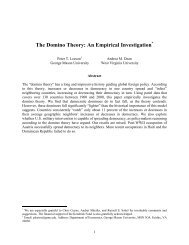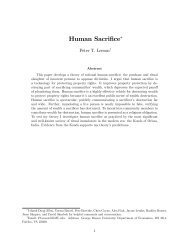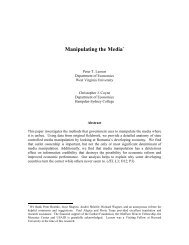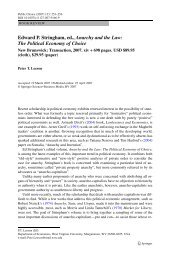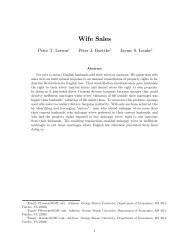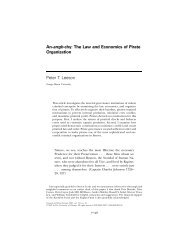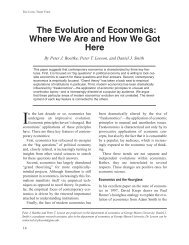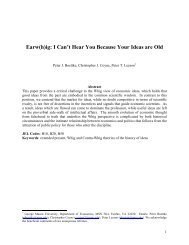The Democratic Domino Theory: An Empirical Investigation
The Democratic Domino Theory: An Empirical Investigation
The Democratic Domino Theory: An Empirical Investigation
Create successful ePaper yourself
Turn your PDF publications into a flip-book with our unique Google optimized e-Paper software.
DEMOCRATIC DOMINO THEORY 547<br />
average geographic neighbors’ changes in democracy. <strong>The</strong><br />
idea that enhancing democracy in a few strategic nations<br />
could substantially alter the extent of democracy in the<br />
rest of the region, for instance, does not appear to be<br />
correct.<br />
Our results point to several conclusions. First, foreign<br />
policy should not pretend that democratic increases<br />
in one country will lead, in the words of President Bush, to<br />
a “democratic revolution” in the larger region it is situated<br />
in. <strong>The</strong> democratic domino effect is modest, and even in<br />
the presence of only a few geographic neighbors, provided<br />
these neighbors are not also independently increasing in<br />
their democracy, minimally affects changes in democracy<br />
in neighboring countries. In the presence of many geographic<br />
neighbors the vast majority of the spread of any<br />
increase (or decrease) in democracy in one country to its<br />
neighbors is overwhelmed by the independent democracy<br />
changes in these countries’ neighbors. In particular, the<br />
“lightness” with which democratic dominoes fall suggests<br />
that even if foreign military intervention aimed at promoting<br />
democracy in undemocratic countries succeeds<br />
in democratizing these nations, intervention is likely to<br />
have only a small effect on democracy in their broader<br />
regions.<br />
Two questions this article does not explore but are<br />
important for evaluating the efficacy of using foreign<br />
military intervention to promote democracy abroad are<br />
as follows: (1) Is military intervention in fact capable of<br />
democratizing foreign countries the intervener occupies?<br />
(2) If yes, do intervention-created democracy increases<br />
spread to neighboring countries, or do they stop at the<br />
occupied country’s borders? If the answers to questions<br />
one and two are positive, a third question also emerges:<br />
(3) Do intervention-created democracy increases spread<br />
to geographic neighbors at the same rate, a stronger<br />
rate, or a weaker rate than internally created democracy<br />
increases?<br />
Existing research has investigated the first question<br />
for the United States as occupier and finds sobering<br />
results. Although there are a handful of intervention<br />
successes that succeeded in promoting democracy in<br />
these countries, notably American occupations of Austria,<br />
Germany, and Japan following WWII, important<br />
work by Peceny (1999, 2000), Lawson and Thacker (2003),<br />
Edelstein (2004), Enterline and Greig (2005), Bueno de<br />
Mesquita and Downs (2005), Coyne (2007), and others<br />
suggests that most U.S. attempts at imposing liberal<br />
democracy abroad have failed. <strong>The</strong> handful of foreign intervention<br />
success stories that do exist, however, point to<br />
the need for an investigation of the second and third questions<br />
posed above. Some preliminary work suggests the<br />
answer to the second question may be negative, rendering<br />
question three moot (see, for example, Boettke, Coyne,<br />
and Leeson 2008). However, this research does not evaluate<br />
these questions using spatial methods, which will help<br />
to supply firmer answers. <strong>The</strong> analysis this article develops<br />
provides a framework for doing so, which future research<br />
should explore.<br />
Appendix A:<br />
Sample Countries<br />
Country 1851–2001 1901–2001 1951–2001 1991–2001<br />
Albania X X<br />
Algeria<br />
X<br />
<strong>An</strong>gola<br />
X<br />
Argentina X X X X<br />
Australia X ∗ X ∗<br />
Austria X X X X<br />
Bahrain<br />
X ∗<br />
Belgium X X<br />
Benin<br />
X<br />
Bhutan X X<br />
Bolivia X X X X<br />
Brazil X X X<br />
Bulgaria X ∗ X X<br />
Burkina Faso<br />
X<br />
Burundi<br />
X<br />
Cambodia<br />
X<br />
continued



